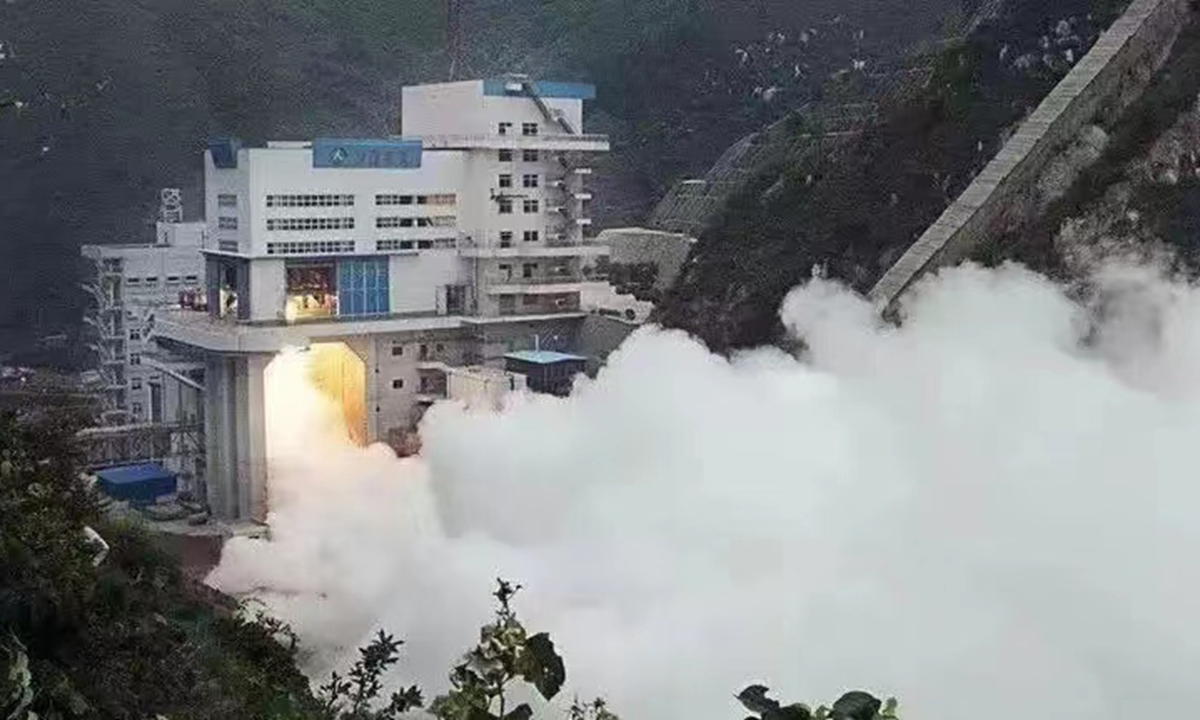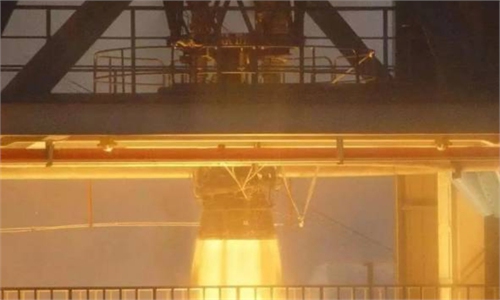China completes 1st flight test of domestically developed reusable engine
Major advance in spacecraft reusability, laying ground for aerospace vehicle

Photo: Courtesy of CASC Sixth Academy
China's aerospace technology researchers announced on Wednesday that for the first time, the country has completed a verification flight test on a domestically developed reusable liquid oxygen kerosene engine, which marks a major breakthrough in engine reusability development.
The reusable engine model was developed by the Xi'an Aerospace Propulsion Institute, a subsidiary of the 6th Academy of the state-owned aerospace giant China Aerospace Science and Technology Corp (CASC).
According to a press release the CASC 6th Academy provided to the Global Times on Wednesday, the engine was used as the main propulsion source for an unnamed vehicle during the maiden flight experiment in 2021. After being inspected and maintained, the engine supported this second flight test, realizing the reuse of liquid rocket propulsion for the first time in China's aerospace history, according to the engine developers.
Zhang Xiaojun, head of the Xi'an-based institute, said it showed that engine reusability technology in the country has reached the stage of practical use. He vowed that they will continue to explore technology solutions in order to provide robust support for the country's space program.
The academy's confirmation of the reusable engine flight test came less than a month after China's announcement of a successful test of a self-developed, reusable sub-orbital vehicle on August 26.
The vehicle was launched "vertically" from the Jiuquan Satellite Launch Center in the Northwest China's Gansu Province, according to the China Academy of Launch Vehicle Technology, the developer of the vehicle, the Xinhua News Agency reported then.
The vehicle lifted off after inspection and maintenance. It was its second launch. The vehicle then completed the sub-orbital flight in accordance with the set procedure and landed "stably and horizontally" at the Alxa Right Banner airport, which marked China's first successful reusable flight of a sub-orbital vehicle, according to Xinhua.
The CASC 6th Academy did not respond to the Global Times inquiries for further details concerning the flight experiment, including the thrust of the engine and the connection between the August flight test and its engine flight test.
However, space observers reached by the Global Times on Wednesday said it's possible there was a deployment of the Xi'an reusable engine during the August sub-orbital vehicle test.
Song Zhongping, a space watcher and TV commentator, told the Global Times on Wednesday that such a liquid oxygen kerosene engine is of great value, as it could not only serve as a rocket engine to work outside the Earth's atmosphere and in near space, but also could be an engine for aerospace vehicles in the future.
The CASC 6th academy revealed on Wednesday's press release that at the design stage, the engine underwent eight consecutive ground tests for reusability. However, repeated success on the ground does not guarantee a win during flight. The second flight using the reusable engine carried major significance, as it verified the engine's adaptability in complex mechanical and thermal environments and the feasibility of post-flight recovery and reuse, and it explored a rapid processing plan as well as the inspection, maintenance and health management plans for such reusable engines.
The US Space Shuttle Main Engine (SSME) achieved partial reusability in the 1980s, but the SSME did not reach its designed capability of being reusable for 55 flights in practice before its retirement with the Space Shuffle in 2011. According to Mark Adler, a former NASA JPL system engineer, each SSME was designed for 55 flights, but they actually flew an average of about 10 flights each.
Technology developed by SpaceX known as the reusable vertical takeoff, vertical landing rocket (VTVL), which conducted a successful landing in 2015 and at a sea platform in 2016, is the latest development of reusable launch vehicle technology in the 21st century.
China's next-generation medium-sized launch vehicle Long March-8 made a successful maiden flight in December 2020. It is believed to have the potential to be reusable. According to plans revealed by the CASC, the first stage of the Long March-8 is expected to become reusable by 10 times by 2025, and by 2035, the entire rocket is expected to be reusable.
Long March-8's enhanced variant in the future might be the first Chinese rocket to become a VTVL launcher, space observers said.
China has carried out step-by-step research for the development of reusable launch vehicles.
China has previously verified step thrust adjustment capability for its domestically developed liquid oxygen kerosene engine during ground running tests, and the capabilities of such thrust adjustment and large-range thrust adjustment have been also tested during flights of the next-generation Long March-8 rocket, according to the CASC 6th academy.
During the Long March-6A maiden flight mission in March, China for the first time realized the application of a flight health monitoring system, and researchers carried out extensive work on the liquid oxygen kerosene engine's performance assessment during the running test and post-flight.

